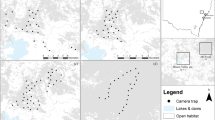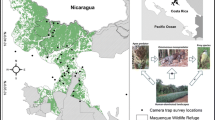Abstract
Increasing densities of generalist mesopredators are a major concern in the conservation of threatened prey species. Knowledge of landscape factors influencing mesopredator abundance is therefore of essential interest to conservation managers. Identification of landscape variables to measure mesopredator abundance necessitates application over a large area. Additionally, the method should be cost effective and applicable in different settings. In our study, we used feces counts to index the relative abundance of red foxes (Vulpes vulpes) in a densely forested mountain range, the Black Forest in Germany. Using a negative binomial regression, we found that landscape diversity and edge density best predicted differences in feces abundance, both showing a positive correlation with feces abundance. We used these results to predict relative red fox abundance for the entire Black Forest and correlated the results with the hunting bag statistic on the municipality level averaged over 11 years. The high correlation between these two independent measures of relative abundance confirmed our results and underlined the usefulness of feces counts to measure abundance of elusive species. The model approach we employed can be used to predict abundance of a wide range of species and regions by identifying factors that influence their abundance.



Similar content being viewed by others
References
Anderson DR (2001) The need to get the basics right in wildlife field studies. Wildlife Soc Bull 29:1294–1297
Andrén H (1992) Corvid density and nest predation in relation to forest fragmentation: a landscape perspective. Ecology 73:794–804
Bang P, Dahlström P, Haltenorth T (2005) Tierspuren—Fährten, Frassspuren, Losungen, Gewölle und andere. Verlag BLV, Munich
Barea-Azcón J, Virgós E, Ballesteros-Duperón E, Moleón M, Chirosa M (2007) Surveying carnivores at large spatial scales: a comparison of four broad-applied methods. Biodivers Conserv 16:1213–1230
Bartoń K (2012) MuMIn: multi-model inference. R package version 1.7.2
Bartoń K, Zalewski A (2007) Winter severity limits red fox populations in Eurasia. Global Ecol Biogeogr 16:281–289
Beasley JC, Olson ZH, Dharmarajan G, Eagan TS, Rhodes OE (2011) Spatio-temporal variation in the demographic attributes of a generalist mesopredator. Landsc Ecol 26:937–950
Bellebaum J (2003) Bestandsentwicklung des Fuchses in Ostdeutschland vor und nach der Tollwutimpfung. Zeitschrift für Jagdwissenschaft 49:41–49
Berger KMI, Gese EM (2007) Does interference competition with wolves limit the distribution and abundance of coyotes? J Anim Ecol 76:1075–1085
Berger KM, Gese EM, Berger J (2008) Indirect effects and traditional trophic cascades: a test involving wolves, coyotes, and pronghorn. Ecology 89:818–828
Bino G, Dolev A, Yosha D, Guter A, King R, Saltz D, Kark S (2010) Abrupt spatial and numerical responses of overabundant foxes to a reduction in anthropogenic resources. J Appl Ecol 47:1262–1271
Braunisch V, Suchant R (2008) Using ecological forest site mapping for long-term habitat suitability assessments in wildlife conservation-demonstrated for capercaillie (Tetrao urogallus). For Ecol Manag 256:1209–1221
Breitenmoser U (1998) Large predators in the Alps: the fall and rise of man’s competitors. Biol Conserv 83:279–289
Burnham KP, Anderson DR (2002) Model selection and multimodel inference: a practical information-theoretic approach. Springer, New York
Constible JM, Chamberlain MJ, Leopold BD (2006) Relationships between landscape pattern and space use of three mammalian carnivores in Central Mississippi. Am Midl Nat 155:352–362
Crooks KR, Soulé ME (1999) Mesopredator release and avifaunal extinctions in a fragmented system. Nature 400:563–566
Dijak WD, Thompson FR (2000) Landscape and edge effects on the distribution of mammalian predators in Missouri. J Wildl Manag 64:209–216
Elmhagen B, Rushton SP (2007) Trophic control of mesopredators in terrestrial ecosystems: top-down or bottom-up? Ecol Lett 10:197–206
Fedriani JM, Fuller TK, Sauvajot RM (2001) Does availability of anthropogenic food enhance densities of omnivorous mammals? An example with coyotes in Southern California. Ecography 24:325–331
Ferreira C, Paupério J, Alves PC (2010) The usefulness of field data and hunting statistics in the assessment of wild rabbit (Oryctolagus cuniculus) conservation status in Portugal. Wildl Res 37:223–229
Forchhammer MC, Asferg T (2000) Invading parasites cause a structural shift in red fox dynamics. Proc Biol Sci 267:779–786
Forchhammer MC, Stenseth NC, Post E, Landvatn R (1998) Population dynamics of Norwegian red deer: density-dependence and climatic variation. Proc Biol Sci 265:341–350
Gauer J, Aldinger E (2005) Waldökologische Naturräume Deutschlands-Wuchsgebiete Schwarzwald und Baar-Wutach. Mitteilungen des Vereins für Forstliche Standortskunde und Forstpflanzenzüchtung 43:281–288
Gustafson EJ (1998) Quantifying landscape spatial pattern: what is the state of the art? Ecosystems 1:143–156
Güthlin D, Kröschel M, Küchenhoff H, Storch I (2012) Faecal sampling along trails: a questionable standard for estimating red fox Vulpes vulpes abundance. Wildl Biol 18:374–382
Harrison RL, Barr DJ, Dragoo JW (2002) A comparison of population survey techniques for swift foxes (Vulpes velox) in New Mexico. Am Midl Nat 148:320–337
Helldin JO, Liberg O, Glöersen G (2006) Lynx (Lynx lynx) killing red foxes (Vulpes vulpes) in boreal Sweden—frequency and population effects. J Zool 270:657–663
Kaphegyi T (2002) Untersuchungen zum Sozialverhalten des Rotfuchses (Vulpes vulpes L.). Dissertation, University of Freiburg
Kays RW, Gompper ME, Ray JC (2008) Landscape ecology of eastern coyotes based on large-scale estimates of abundance. Ecol Appl 18:1014–1027
Keuling O, Greiser G, Grauer A, Strauß E, Bartel-Steinbach M, Klein R, Wenzelides L, Winter A (2011) The German wildlife information system (WILD): population densities and den use of red foxes (Vulpes vulpes) and badgers (Meles meles) during 2003–2007 in Germany. Eur J Wildl Res 57:95–105
Kiner TV, Zaitsev VA (2010) Range structure in the red fox (Vulpes vulpes L.) in the forest zone of Eastern Europe. Contempor Probl Ecol 3:119–126
König A, Romig T (2010) Fox tapeworm Echinococcus multilocularis. Wildl Biol 16:258–266
Kurki S, Lindén H (1995) Forest fragmentation due to agriculture affects the reproductive success of ground-nesting black grouse Tetrao tetrix. Ecography 18:109–113
Kurki S, Nikula A, Helle P, Lindén H (1998) Abundances of red fox and pine marten in relation to the composition of boreal forest landscapes. J Anim Ecol 67:874–886
Kurki S, Nikula A, Helle P, Lindén H (2000) Landscape fragmentation and forest composition effects on grouse breeding success in boreal forests. Ecology 81:1985–1997
Legendre P, Legendre L (1998) Numerical ecology. Elsevier, Amsterdam
Mangas JG, Rodríguez-Estival J (2010) Logging and livestock influence the abundance of common mammal species in Mediterranean forested environments. For Ecol Manag 260:1274–1281
Mortelliti A, Boitani L (2008) Interaction of food resources and landscape structure in determining the probability of patch use by carnivores in fragmented landscapes. Landsc Ecol 23:285–298
Oehler JD, Litvaitis JA (1996) The role of spatial scale in understanding responses of medium-sized carnivores to forest fragmentation. Can J Zool 74:2070–2079
Pegel M (2001) Zur Bestandssituation des Dachses in Baden-Württemberg. WFS-Mitteilungen 1:1–4
Pielou EC (1975) Ecological diversity. Wiley-Interscience, New York
Pita R, Mira A, Moreira F, Morgado R, Beja P (2009) Influence of landscape characteristics on carnivore diversity and abundance in Mediterranean farmland. Agric Ecosyst Environ 132:57–65
Prugh LR, Stoner CJ, Epps CW, Bean WT, Ripple WJ, Laliberte AS, Brashares JS (2009) The rise of the mesopredator. Bio Sci 59:779–791
R Development Core Team (2011) R: a language and environment for statistical computing. Vienna, Austria
Rosalino LM, Macdonald DW, Santos-Reis M (2004) Spatial structure and land-cover use in a low-density Mediterranean population of Eurasian badgers. Can J Zool 82:1493–1502
Rosalino LM, Macdonald DW, Santos-Reis M (2005) Resource dispersion and badger population density in Mediterranean woodlands: is food, water or geology the limiting factor? Oikos 110:441–452
Rosalino LM, Santos M, Beier P, Santos-Reis M (2008) Eurasian badger habitat selection in Mediterranean environments: does scale really matter? Mamm Biol 73:189–198
Rotem G, Berger H, King R, Kutiel PB, Saltz D (2011) The effect of anthropogenic resources on the space-use patterns of golden jackals. J Wildl Manag 75:132–136
Sadlier LM, Webbon CC, Baker PJ, Harris S (2004) Methods of monitoring red foxes (Vulpes vulpes L.) and badgers (Meles meles): are field signs the answer? Mamm Rev 34:75–98
Selas V, Vik JO (2006) Possible impact of snow depth and ungulate carcasses on red fox (Vulpes vulpes) populations in Norway, 1897–1976. J Zool 269:299–308
Sidorovich VE, Sidorovich AA, Izotova IV (2006) Variations in the diet and population density of the red fox (Vulpes vulpes) in the mixed woodlands of northern Belarus. Mamm Biol 71:74–89
Sidorovich VE, Tikhomirova LL, Solovej IA (2007) Distribution of rodents and their predators in transitional mixed woodland in relation to exposure of terrestrial vegetation in northern Belarus. Acta Zoologica Lituanica 17:323–332
Simpson EH (1949) Measurement of diversity. Nature 163:688
Soulé ME, Bolger DT, Alberts AC, Wright J, Sorice M, Hill S (1988) Reconstructed dynamics of rapid extinctions of chaparral-requiring birds in urban habitat islands. Conserv Biol 2:75–92
Storch I, Woitke E, Krieger S (2005) Landscape-scale edge effect in predation risk in forest-farmland mosaics of central Europe. Landsc Ecol 20:927–940
Thompson CM, Gese EM (2007) Food webs and intraguild predation: community interactions of a native mesocarnivore. Ecology 88:334–346
Virgós E, Tellería JL, Santos T (2002) A comparison on the response to forest fragmentation by medium-sized Iberian carnivores in central Spain. Biodivers Conserv 11:1063–1079
Zalewski A, Jędrzejewski W (2006) Spatial organisation and dynamics of the pine marten (Martes martes) population in Białowieza Forest (E Poland) compared with other European woodlands. Ecography 29:31–43
Acknowledgments
We thank Mareike Brix, Britta Dingeldein, Dorothee März, Yitagesu Telke and Felix Wildi for helping us with searching line transects for fox feces. We thank Elizabeth Glatthaar and John A. Bissonette for providing language help and for proof reading the article, the coordinating editor and two anonymous reviewers for their helpful comments and the Regierungspräsidium Freiburg for their cooperation during field work. This work was funded by the Ministerium für Ländlichen Raum, Ernährung und Verbraucherschutz Baden-Württemberg.
Author information
Authors and Affiliations
Corresponding author
Electronic supplementary material
Below is the link to the electronic supplementary material.
Rights and permissions
About this article
Cite this article
Güthlin, D., Storch, I. & Küchenhoff, H. Landscape variables associated with relative abundance of generalist mesopredators. Landscape Ecol 28, 1687–1696 (2013). https://doi.org/10.1007/s10980-013-9911-z
Received:
Accepted:
Published:
Issue Date:
DOI: https://doi.org/10.1007/s10980-013-9911-z




